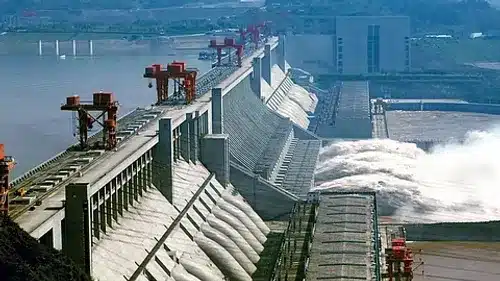In July 2025, China commenced construction on what will become the largest hydropower dam in the world, situated in Medog County, located within the Tibet Autonomous Region. This ambitious infrastructure project is expected to generate 60 gigawatts (GW) of electricity—nearly three times the output of the famous Three Gorges Dam—cementing China’s global dominance in large-scale renewable energy and marking a milestone as the world’s largest hydropower dam.
Project Overview
-
Location: Lower Yarlung Zangbo River (Brahmaputra), Medog County, Tibet
-
Announced: July 2025
-
Developer: State Power Investment Corporation (SPIC)
-
Expected Capacity: ~60 GW (Gigawatts)
-
Annual Output: Approx. 300 billion kilowatt-hours
-
Estimated Completion: 2033
-
Estimated Cost: ~1.2 trillion yuan (~USD 167 billion)
-
Construction Type: Cascade system – multiple dams along the same river
Once completed, the dam will surpass the capacity of the Three Gorges Dam (22.5 GW), currently the world’s largest, and will contribute significantly to China’s renewable energy output.
Why Tibet?
The Yarlung Zangbo River, which becomes the Brahmaputra in India and Bangladesh, descends through one of the deepest canyons on Earth. The steep elevation drop of over 2,000 meters in less than 100 km allows the harnessing of gravitational force for efficient energy generation.
Tibet’s remote location also aligns with China’s broader strategy of integrating and developing its border regions while strengthening its renewable energy grid in western provinces.
Strategic Importance
1. National Energy Goals
China is under pressure to meet its carbon neutrality goal by 2060. This dam, part of a broader shift to hydro, wind, and solar, will:
-
Replace coal-fired power in parts of central and eastern China
-
Increase renewable energy’s share in national electricity supply
-
Help stabilize grid supply from west to east via ultra-high-voltage (UHV) transmission lines
2. Infrastructure Diplomacy
China is increasingly using large-scale infrastructure as a tool for both domestic development and international soft power. The dam demonstrates engineering capacity and adds weight to the Belt and Road Initiative (BRI) narrative, although the dam is not officially part of BRI.
Environmental and Social Concerns
Despite its technical merits, the dam has drawn criticism from environmentalists, hydrologists, and human rights groups.
Environmental Risks:
-
Seismic zone: Tibet lies in a tectonically active region, raising earthquake and landslide risks
-
Biodiversity loss: Potential disruption to rare and endemic species in the canyon ecosystem
-
Altered sediment flow: Impacts on downstream agricultural productivity
-
Flood risk: Mismanagement or dam failure could have severe cross-border consequences
Social and Cultural Impact:
-
The project may lead to displacement of indigenous Tibetan communities, although official figures are not yet public
-
It could also affect religious or culturally significant sites in the region
Geopolitical Reactions
India and Bangladesh’s Concerns
The dam is upstream of two countries that rely heavily on the Brahmaputra for agriculture, fisheries, and freshwater. Neither India nor Bangladesh has a water-sharing treaty with China regarding this river, which raises alarm over:
-
Potential water shortages during dry seasons
-
Flooding due to sudden dam releases during monsoons
-
Lack of transparency in river flow data from China
India’s Ministry of External Affairs has called for international cooperation on transboundary river governance, while Bangladesh has echoed the need for multilateral water-sharing frameworks.
What It Means for Africa
For African countries developing their own hydropower capacities—such as Ethiopia (GERD), DRC (Inga Dams), and Zambia—China’s project offers both inspiration and caution:
-
Inspiration: Proof that large-scale renewable energy is feasible with government backing
-
Caution: Highlights the risks of cross-border water conflict and the need for inclusive planning
China’s hydropower dam in Tibet is poised to break global records in scale, efficiency, and ambition. But with this power comes responsibility. Environmental stewardship, international cooperation, and respect for local communities must accompany the technical success of this project.
Read also China’s Yarlung Tsangpo Mega Dam: The World’s Largest Hydropower Project and Its Regional Impact
